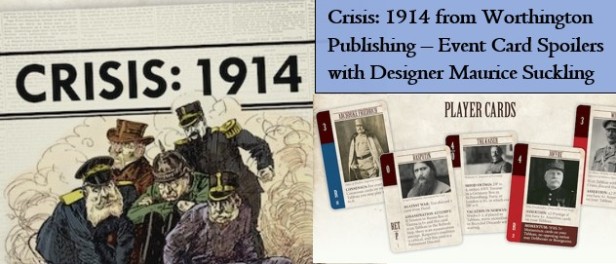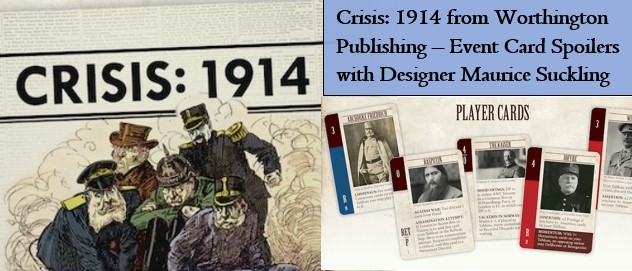We became acquainted with Maurice Suckling with his game Freeman’s Farm 1777 from Worthington Publishing in 2019 and really enjoyed the mechanics and how they all came together to create an interactive and interesting look at the Battle of Saratoga during the American Revolution. Since that time, Maurice has designed several other games that have went on to successful Kickstarter campaigns including Hidden Strike: American Revolution, Chancellorsville 1863 and 1565 Siege of Malta. He is now working on a game that is tied to the buildup of tensions that led to the outbreak of The Great War called Crisis: 1914 from Worthington Publishing, which was successfully funded on Kickstarter this past summer. He has prepared a series of Event Card Spoilers for the game and we are hosting them here on the blog. These posts will share the cards basis in history as well as how they are used in the game.

If you are interested in ordering Crisis: 1914, you can pre-order a copy for $65.00 from the Worthington Publishing website at the following link: https://www.worthingtonpublishing.com/collection/crisis-1914-pre-order-this-game-will-not-ship-until-february-2024

Card #18 – Alfred von Tirpitz – State Secretary of the Navy
For nearly two decades prior to the crisis, Admiral Alfred von Tirpitz guided the expansion of the Imperial German Navy with the express strategic goal of challenging British naval superiority (Clark 2012, 148-150). His experience with this program influenced his pragmatic approach to war during the crisis itself: Tirpitz was well aware that Germany was not yet equipped to defeat the Royal Navy, and he was known to push back against orders that risked sacrificing or undermining Germany’s strategic advantages at the start of the war (Martel 2014, 204, 330; McMeekin 2013, 351-352).
Admiral Tirpitz was away from Berlin on holiday for much of the Crisis, including at the time of the assassinations in Sarajevo, and did not return until July 27th (McMeekin 2013, 80, 222-223).

Card #19 – Mobilization Timetables
Regardless of the possibility that the German military leveraged the Schlieffen Plan primarily as a means to generate funding, rather than for genuine belief in its likely efficacy (Beatty 2012, 251-252), the Schlieffen Plan was the driving force behind German concerns over mobilization timetables. The fear of the size of the Russian army and the assessment that it would be slow to mobilize drove the strategy to focus on the western front first. The plan was to launch a massive enveloping maneuver of the French left, which would defeat France rapidly (within forty-two days) and then allow the Germans to swing the army around to defeat the Russians (Raicer 2009, 25-6). The nature of the plan contributed to the likelihood of war. Some historians even consider its six-week time limit to have made war unavoidable – “because the strict timetable was based on the Russian rate of mobilization, the Czar’s decision to mobilize led to Moltke’s demand that the plan be implemented immediately” (Raicer 2009, 12).
Card #20 – Erich von Falkenhayn – Prussian Minister for War

A consistent supporter of war and early proponent of Kriegsgefahrzustand (a state of war emergency, or threatening danger). After ordering the army to initiate “a few [relatively minor] precautionary measures” on July 28th, General Falkenhayn openly pushed for a declaration of Kriegsgefahrzustand on July 29th (McMeekin 2013, 267, 274, 276; Otte 2014, 382). He would subsequently push Bethmann Hollweg for full mobilization on August 1st (McMeekin 2013, 341).
Falkenhayn left for his annual holiday at some point in the middle of July. The exact date is unclear, but it seems to have followed “an inspection tour” and overlapped in part with absences of General Moltke and Admirals Tirpitz and Pohl (Martel 2014, 108-109; Clark 2012, 516).
Card #21 – General Helmuth von Moltke – Chief of the Imperial German General Staff

An advocate for rapid action against Serbia and the architect of Germany’s mobilization plan, Helmuth von Moltke predicted the inevitability of a European conflict as early as December 1912 during the First Balkan War (McMeekin 2013, 84, 266). He also shared with Jagow the conviction that Russia posed the most pressing threat to Germany and, as a result, emphasized speed as the best – and perhaps only – means of ensuring Germany’s survival in such a war (McMeekin 2013, 84, 288-290).
It was thus Moltke who constructed the plan to advance through Belgium, overwhelm France, and then return to face an isolated Russia (McMeekin 2013, 404-405). Despite his careful calculations, though, Wilhelm intervened on August 1st when it appeared that Britain had guaranteed its neutrality – if Germany would refrain from attacking France. The mobilizing forces, according to him, could now be shifted entirely toward Russia; Moltke immediately objected, and the Kaiser retaliated, “Your uncle [Moltke the Elder] would have given me a different answer” (McMeekin 2013, 342-343). This remark, and the alteration of his plans, stuck with Moltke, who later claimed that “something in me broke and I was never the same again” (Carter 2009, 438). He would soon thereafter suffer a breakdown and resign from his post (Carter 2009, 438).
In terms of health, it is also worth noting that Moltke was away from Berlin for most of the Crisis: he suffered from acute liver disease and holidayed each year in the spas of Karlsbad (Otte 2014, 64-65; McMeekin 80). Although he only returned on July 26th, he remained in regular contact with his colleagues, especially General Falkenhayn, throughout its duration (Mombauer 1999, 424).
Card #22 – Albert Ballin – Shipping Magnate and Mediator

At the start of the July Crisis, the German-Jewish Albert Ballin served as head of the Hamburg-America Line, a transatlantic shipping line, and boasted an extensive network of connections in both Germany and Britain. Although he was not officially employed by the German government, his close relationships with some of its more prominent figures occasionally prompted them to rely on him as a “shipping diplomat” when dealing with foreign powers (Otte 2014, 259).
Ballin willingly filled this role during the Crisis at the behest of Gottlieb von Jagow. Fearful of a potential Anglo-Russian naval agreement – and less than satisfied with Prince Lichnowsky – Jagow turned to Ballin in the hope that he might be able to not only gauge Britain’s potential response to a continental war, but also prevent any strengthening of ties between Britain and Russia. Ballin, who already had business in Britain, traveled to London on July 20th (Martel 2014, 141-142; Otte 2014, 259).
On July 24th, he dined with a small group of British ministers, including Grey, Richard Haldane, and John Morley. As he recalled, the group insisted that their primary concern was a German annexation of French territory: as long as Germany refrained from doing so, Britain would remain neutral and Anglo-German relations would remain effectively unchanged (Martel 2014, 301; Otte 2014, 259-260). While this was not entirely correct in fact, Ballin’s report of the conversation nevertheless suggested to Jagow that British involvement and an escalation of war could still be avoided (Otte 2014, 260).
Card #23 – Halt in Belgrade

A proposal by Kaiser Wilhelm II that attempted to stave off a continental war. On July 28th, Wilhelm wrote a letter to Gottlieb von Jagow suggesting that Austria-Hungary be allowed to occupy Belgrade – as a “forfeit” – until Serbia actually implemented the changes outlined in the ultimatum; Wilhelm, in turn, would serve as mediator and advocate for a subsequent peaceful resolution to the conflict in Vienna (Otte 2014, 346-347). Although the proposal was ultimately undermined by Jagow and Tschirschky, the broader idea persisted until the Russian mobilization in the form of an independent plan by Grey (Otte 2014, 352-354, 386, 390, 397).
If you missed the previous entries in the series, you can catch up on the posts to date by following the below links:
Series Introduction and General Mobilization Cards
If you are interested, we posted an interview with the designer and you can read that at the following link: https://theplayersaid.com/2023/07/12/interview-with-maurice-suckling-designer-of-crisis-1914-from-worthington-publishing-currently-on-kickstarter/
-Grant
